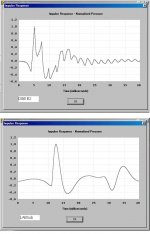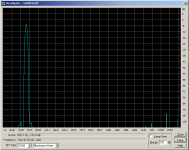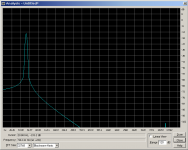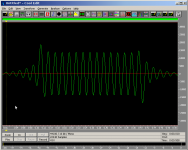Hi. I haven't bothered to read any of this thread yet, only the subject. Here's my opinion..
1st order lowpass, no highpass, sealed only, careful selection of drivers, and loads of Sd (if SPL is of any importance), no 'subwoofers'.
..just my $0.02.
1st order lowpass, no highpass, sealed only, careful selection of drivers, and loads of Sd (if SPL is of any importance), no 'subwoofers'.
..just my $0.02.
There is not such a thing as "slow" or "fast" bass. It's all a matter of balance between bottom end (30-80Hz) and top end (80-250Hz). Room acoustics (that tend to boost bottom end and cancel top end) and proper acoustic summing (acoustic phase matching between woofers and subwoofers when there is a crossover in the middle) are the things to care about.
Bass reflex vs bandpass vs sealed has little to do if proper eq and phase matching is applied to the system. Group delay has little to do either (as long as it's matched too). This requires intentional misalignment of the enclosures and crossover filters, and/or all-pass filters.
Sealed has a progressive 180 degree phase jump across the bottom octave, bass reflex has a 360 degree jump, like 4th order bandpass, and 6th BP has another 360 degree jump on the top end. A system can't produce proper bass without dealing with this (plus potentially unmatched delays in sound propagation from source to listener).
Use ideal alignments for the enclosures (no matter if sealed or reflex or BP) and ideal filters without additional phase/delay compensation and you will get the bass wrong, almost guaranteed.
Bass reflex vs bandpass vs sealed has little to do if proper eq and phase matching is applied to the system. Group delay has little to do either (as long as it's matched too). This requires intentional misalignment of the enclosures and crossover filters, and/or all-pass filters.
Sealed has a progressive 180 degree phase jump across the bottom octave, bass reflex has a 360 degree jump, like 4th order bandpass, and 6th BP has another 360 degree jump on the top end. A system can't produce proper bass without dealing with this (plus potentially unmatched delays in sound propagation from source to listener).
Use ideal alignments for the enclosures (no matter if sealed or reflex or BP) and ideal filters without additional phase/delay compensation and you will get the bass wrong, almost guaranteed.
auplater said:
BINGO!!
All the talk about uncontrolled resonances, etc... is mindless w/o mentioning the room and location of the sub(s)... since most any room has all sorts of resonances and reflections impacting the reproduction. In fact, the room resonance profile defines the bass reproduction, the speakers only provide the drive for these modes.
In most instances, the room dominates the reproduction quality below say 100 hz, so fast and slow applied to the drivers doesn't seem to apply much. So deal with the room modes (through placement, multiple sources, etc.) and bass quality will be dramatically enhanced. Chasing driver characteristics pretty much misses the point, imo
John L.
It's starting to sound like you're going to the other extreme!
The room is important, it's part of the system. A bad room can ruin an accurate subwoofer, but a crappy subwoofer will never sound accurate, no matter how ideal the room is.
In a room that has been tamed reasonably well, and where you have achieved the ideal frequency response, two different subs can sound very different. One can sound like a subwoofer, while the other sounds like whatever source you are playing.
There is not such a thing as "slow" or "fast" bass.
Fast bass is a subjective term. You may not like it, you may think it's a poor choice of words, but when a large number of people use a word in the same way, it eventually ends up in the dictionary. Love it or hate it, I'm guessing it's a term that's here to stay.
I prefer to use the word accurate, but when people use the term I know what they mean. I don't see the sense in arguing.
It's when I see audiophile mythology coming out, I can't resist ...
<Off topic alert>
This is one that amazes me. I was talking to the owner of a pro audio store, he described himself as an engineer. We had a good chat and he passed on some very useful info about getting amps repaired and some cheap pro amps to be avoided. But then he came out with an old myth. If the room isn't as big as the wavelength of a particular frequency, then it can't be reproduced in that room! Hmmm, so how do headphones work?!
</Off topic alert>
Eva said:Sealed has a progressive 180 degree phase jump across the bottom octave, bass reflex has a 360 degree jump, like 4th order bandpass, and 6th BP has another 360 degree jump on the top end. A system can't produce proper bass without dealing with this (plus potentially unmatched delays in sound propagation from source to listener).
Eva,
Are you referring to the low frequency group delay caused by high-pass filtering that needs to be compensated in the "top end" or are you talking about a different effect?
This, in addition to multiple sources at multiple distances would mean that each subwoofer needs it's own delay relative to the mains (i.e. may be negative time)
Hmmm...
But the problem is that it's not clear that everyone is using it the same way at all.paulspencer said:...Fast bass is a subjective term. You may not like it, you may think it's a poor choice of words, but when a large number of people use a word in the same way, it eventually ends up in the dictionary...
Iain McNeill said:
Eva,
Are you referring to the low frequency group delay caused by high-pass filtering that needs to be compensated in the "top end" or are you talking about a different effect?
This, in addition to multiple sources at multiple distances would mean that each subwoofer needs it's own delay relative to the mains (i.e. may be negative time)
Hmmm...
I'm referring to the phase response of the speaker+enclosure system itself. You can't expect proper summing if you just mix things with 180º and 360º phase jumps on them, even if the crossover itself produces a perfect electrical sum (like LR). This is the most usual mistake. There is substantial phase shift already on the passband, well above lower cutoff.
Eva, I believe what you are saying is important
In a 3way many people seem to prefer reversed polarity on both mid and tweeter, or just the woofer, which puzzles me a bit
I can only make my 3way work with reversed mid, and I have tried every other options
I reckon my crossover is just different from others, though it doesnt look that much different
But it sounds like you are saying that which driver needs reversed polarity, just as well depends on woofer box design, whether being closed or BR, or something else
Well, it would make sense, somehow
edit, does a simulation software make such "considerations" ?
In a 3way many people seem to prefer reversed polarity on both mid and tweeter, or just the woofer, which puzzles me a bit
I can only make my 3way work with reversed mid, and I have tried every other options
I reckon my crossover is just different from others, though it doesnt look that much different
But it sounds like you are saying that which driver needs reversed polarity, just as well depends on woofer box design, whether being closed or BR, or something else

Well, it would make sense, somehow
edit, does a simulation software make such "considerations" ?
paulspencer said:
Fast bass is a subjective term. You may not like it, you may think it's a poor choice of words, but when a large number of people use a word in the same way, it eventually ends up in the dictionary. Love it or hate it, I'm guessing it's a term that's here to stay.
A large number of people used the word flat to describe the shape of the earth in the 15:th century too. That did too end up in dictionaries and encyclopedias.
However, just because 95 % of the earths population where uneducated and believed that the earth was flat did not make it so.
Most audiophiles use the term "fast bass" in the same way. They mean "tight and accurate."
That really isn't the same thing. When they called the earth flat, they meant it literally. They weren't saying it looks flat, so let's call it that. They actually believed the earth was flat.
Fast bass is a purely subjective term that is widely used and shouldn't be taken literally any more than calling a woman "hot" is referring to temperature.
Interesting article on fast bass and one concept of how it is achieved:
http://www.soundstage.com/maxdb/maxdb061999.htm
A large number of people used the word flat to describe the shape of the earth in the 15:th century too. That did too end up in dictionaries and encyclopedias. However, just because 95 % of the earths population where uneducated and believed that the earth was flat did not make it so.
That really isn't the same thing. When they called the earth flat, they meant it literally. They weren't saying it looks flat, so let's call it that. They actually believed the earth was flat.
Fast bass is a purely subjective term that is widely used and shouldn't be taken literally any more than calling a woman "hot" is referring to temperature.
Interesting article on fast bass and one concept of how it is achieved:
http://www.soundstage.com/maxdb/maxdb061999.htm
chris661 said:The fastest bass I've heard was from a sealed box, and there is reasoning behind this.
Ported/bandpass systems rely on ports to delay the sound 1/2 a cycle, the send it out roughly in phase with the sound from the front of the woofer.
The subjective experience of "Fast bass" usually is attributed to planar speakers. The stored energy inherent with sealed sub, or worse - ported cabinets, may have something to do with "slow bass".
Dipole woofers (either planar or dynamic) do sound tight and accurate.
Beg to disagree
I've had multiple sonotube ported subwoofers for over 10 years, and have never suffered "slow bass". Currently have four set up as follows:
-12" EBS sonosub configured in front right corner behind 6' planar mains
- Dual 10" isobaric along right wall ~ 1/2 distance 3 feet out behind side sofa
-12" sonosub diagonally opposite right front corner ~ 25 feet away maybe 6 feet from back wall
- 12" sonobub on 2nd floor crosswalk across cathedral ceiling HT/audio setup, midway across room
With this setup, bass is profoundly deep, extending below 20 Hz at > 105 dB, evenly disbursed throughout the room. Plucked string bass is really cool to listen to, as is slap bass, especially runs up the bottom octave or so. Organ works are phenomenal; the sense of upwelling presence and that slightly fearful feeling I get when hearing an organ in a cathedral, where the low frequencies seem to come from everywhere and "take over" your body are there.
Also compelling is the accuracy of the bass notes. Gone is that sense that there should be bass, but it's more imagined than heard. The differentiation of the tonal quality of a run down the bottom octave is palpable, and movie specially effects are downright frightening.
I arrived at this setup after years of moving a single sub around trying to get it to integrate with my then Infinity RS II's, to minimal effect. In the mid '90's I built the isobaric sub as a second sub and this helped immensely towards more integrated deep bass. Most recently, after reading the Harman work and that of dr. geddes on multi-sub approaches, I confirmed that my empirically determined setup closely matches what they propose for quality bass.
Mains:
Sonosub:
BTW: the subs are not especially expensive, the sonosubs cost maybe $150 each, for instance and use $50 car subs.
John L.
gainphile said:
The subjective experience of "Fast bass" usually is attributed to planar speakers. The stored energy inherent with sealed sub, or worse - ported cabinets, may have something to do with "slow bass".
Dipole woofers (either planar or dynamic) do sound tight and accurate.
I've had multiple sonotube ported subwoofers for over 10 years, and have never suffered "slow bass". Currently have four set up as follows:
-12" EBS sonosub configured in front right corner behind 6' planar mains
- Dual 10" isobaric along right wall ~ 1/2 distance 3 feet out behind side sofa
-12" sonosub diagonally opposite right front corner ~ 25 feet away maybe 6 feet from back wall
- 12" sonobub on 2nd floor crosswalk across cathedral ceiling HT/audio setup, midway across room
With this setup, bass is profoundly deep, extending below 20 Hz at > 105 dB, evenly disbursed throughout the room. Plucked string bass is really cool to listen to, as is slap bass, especially runs up the bottom octave or so. Organ works are phenomenal; the sense of upwelling presence and that slightly fearful feeling I get when hearing an organ in a cathedral, where the low frequencies seem to come from everywhere and "take over" your body are there.
Also compelling is the accuracy of the bass notes. Gone is that sense that there should be bass, but it's more imagined than heard. The differentiation of the tonal quality of a run down the bottom octave is palpable, and movie specially effects are downright frightening.
I arrived at this setup after years of moving a single sub around trying to get it to integrate with my then Infinity RS II's, to minimal effect. In the mid '90's I built the isobaric sub as a second sub and this helped immensely towards more integrated deep bass. Most recently, after reading the Harman work and that of dr. geddes on multi-sub approaches, I confirmed that my empirically determined setup closely matches what they propose for quality bass.
Mains:
An externally hosted image should be here but it was not working when we last tested it.
Sonosub:
An externally hosted image should be here but it was not working when we last tested it.
BTW: the subs are not especially expensive, the sonosubs cost maybe $150 each, for instance and use $50 car subs.
John L.
gainphile said:
The subjective experience of "Fast bass" usually is attributed to planar speakers. The stored energy inherent with sealed sub, or worse - ported cabinets, may have something to do with "slow bass".
Dipole woofers (either planar or dynamic) do sound tight and accurate.
You can get a dipole and a monopole to sound so close you probably wouldn't pick the difference in a blind test. I've done a little test of my two subs, one monopole, the other H frame dipole - both eq'd to match. The difference? Somewhere around the limits of audibility.
paulspencer said:You can get a dipole and a monopole to sound so close you probably wouldn't pick the difference in a blind test. I've done a little test of my two subs, one monopole, the other H frame dipole - both eq'd to match. The difference? Somewhere around the limits of audibility.
How high are they cut?
paulspencer said:
It's starting to sound like you're going to the other extreme!
The room is important, it's part of the system. A bad room can ruin an accurate subwoofer, but a crappy subwoofer will never sound accurate, no matter how ideal the room is.
In a room that has been tamed reasonably well, and where you have achieved the ideal frequency response, two different subs can sound very different. One can sound like a subwoofer, while the other sounds like whatever source you are playing.
I don't disagree in principal... but you've added a bunch of conditions. Most rooms have dominant modes that swamp the speaker contribution as an additional (non)modal source, and until you rein in the modal response such that said modes complement rather than dominate, you're fighting a no-win situation.
That seems to be where multiple subs adds a dimension of control, since, in a certain sense, you're adding modes to a room in a controlled fashion
paulspencer said:
I prefer to use the word accurate, but when people use the term I know what they mean. I don't see the sense in arguing.
It's when I see audiophile mythology coming out, I can't resist ...
<Off topic alert>
This is one that amazes me. I was talking to the owner of a pro audio store, he described himself as an engineer. We had a good chat and he passed on some very useful info about getting amps repaired and some cheap pro amps to be avoided. But then he came out with an old myth. If the room isn't as big as the wavelength of a particular frequency, then it can't be reproduced in that room! Hmmm, so how do headphones work?!
</Off topic alert>
hehe.. he needs to study sound perception... reminds me of the old Cerwin-vega claim from the '70's that their speakers could be plugged directly into a 120V wall socket and would reproduce 60 hz long term... NOT!!
John L.
Most rooms have dominant modes that swamp the speaker contribution
"Most rooms" is a very broad category. I've used eq in 3 rooms and was easily able to get them flat without needing any special placement, or more than one sub. All 3 rooms were small to medium in size and lightly constructed like many Australian homes. Easy to tame, and along with the absence of difficult room modes, they also lack significant room gain. The whole room acts as a bass trap.
Rooms with concrete floors and masonry walls will be very different. And basement rooms are an extra level of challenge.
Telstar,
80 Hz
planet10 said:Fast is just a bad term to use. Simply, a fast woofer has good hi-frequency response. Put a low pass filter on it, and it is no longer fast.
That's right. Have a look at this. First pic is a spectral response of a continuous 40Hz sinewave. No big deal. Second pic is for 1 second silence, 1 second 40Hz, 1 second silence. The 40Hz starts and stops on the zero crossing. Notice the tone burst has a lot more high frequency content even though it is still nominally a 40Hz sinewave. A "fast" woofer going doof-doof-doof needs more high frequency response to sound "fast"
Attachments
- Status
- Not open for further replies.
- Home
- Loudspeakers
- Subwoofers
- Options for fast bass




